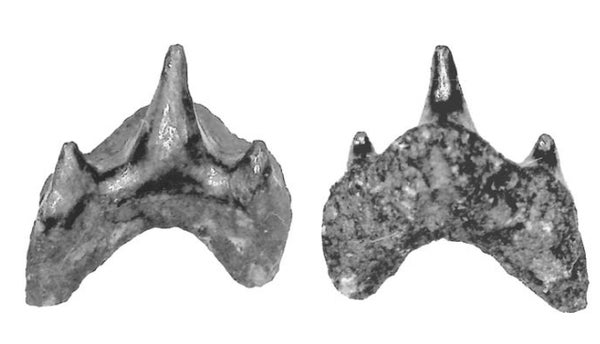This article was published in Scientific American’s former blog network and reflects the views of the author, not necessarily those of Scientific American
No one was expecting the megamouth shark. The fish's discovery came as a complete surprise when one of the bulky filter-feeders became entangled in a U.S. Navy ship's anchor in 1976. This not only revealed the presence of an previously-unknown ocean giant, but raised the question of when these sharks evolved and how long they've been sieving the seas. A fossil tooth found in Denmark helps answer those questions.
The singular fossil, described by paleontologists Kenshu Shimada and David Ward, is about 36 million years old. This is now the earliest known occurrence of a megamouth shark, extending the ancestry of these sharks 13 million years further back in time and also offering new clues about what the first megamouths were like.
Many of the teeth found at the same site, Shimada and Ward write, are intact despite their 36-million-year-long rest in the rock. The tip of the Megachasma alisonae tooth is broken, however, which might mean that this shark was still biting prey rather than catching plankton with gill rakers like the modern megamouth. More importantly, though, the fossil megamouth tooth somewhat resembles that of a sandtiger shark. This might mean that there are even older megamouth fossils out there that has been misidentified as ancient sandtigers. Time, and teeth, will tell.

The tooth of Megachasma alisonae. Credit: Shimada and Ward, 2016
Fossil Facts
On supporting science journalism
If you're enjoying this article, consider supporting our award-winning journalism by subscribing. By purchasing a subscription you are helping to ensure the future of impactful stories about the discoveries and ideas shaping our world today.
Name: Megachasma alisonae
Meaning: Megachasma is the genus of the living megamouth shark, and the species name honors Alison Ward for sorting the sediment that allowed this new species to be discovered.
Age: Eocene, around 36 million years old.
Where in the world?: Moesgård Strand, Denmark.
What sort of critter?: A megamouth shark.
Size: Estimated at between 4.2 and 11.5 feet long.
How much of the creature’s body is known?: A single, nearly-complete tooth.
Reference:
Shimada, K., Ward, D. 2016. The oldest fossil record of the megamouth shark from the late Eocene of Denmark, and comments on the enigmatic megachasmid origin. Acta Palaeontologica Polonica. doi: 10.4202/app.00248.2016
Previous Paleo Profiles:
The Light-Footed Lizard The Maoming Cat Knight’s Egyptian Bat The La Luna Snake The Rio do Rasto Tooth Bob Weir's Otter Egypt's Canine Beast The Vastan Mine Tapir Pangu's Wing